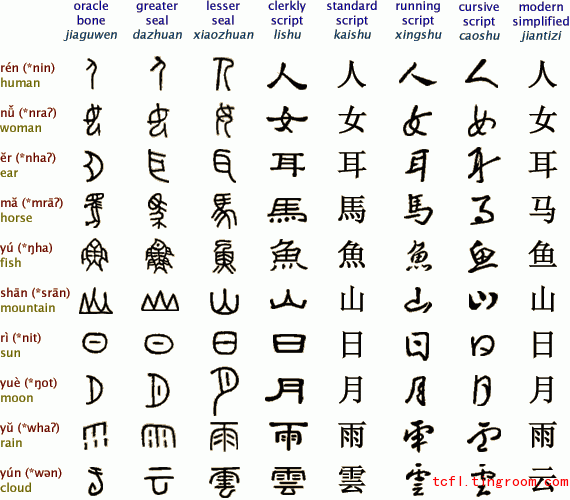based on pictographs, Chinese characters combine shapes with sounds and connotations to form unique, block-shaped characters that carry meaning. Archaeological researchers discovered many such signs carved on earthenware excavated from Banpo Village in Xi’an City and Jiangzhai Village in Lintong. The etchings were carved during the Yangshao Culture Period some 6,000 years ago. More than 4,000 years ago, people living in the Tai’an area of Shandong Province also carved signs on earthenware. The character “旦” (dan in pin yin, meaning dawn), for instance; the sun (日) rises upwards, crossing the mountains and passing through cloud layers to tell people a new day has begun. It is safe to say that the earthenware signs are the first Chinese characters, which originated from drawings.
The most sophisticated and earliest Chinese characters are the inscriptions on tortoise shells and animal bones called Jiaguwen of the Shang Dynasty (17th-11th century BC) that resemble drawings. To date, China has unearthed 150,000 pieces of animal bone and tortoise shell, including more than 4,600 distinctive Chinese characters, among which more than 1,700 have been identified. The inscriptions on bones and shells consist of phrases and simple sentences, providing much insight into the Shang Dynasty. Modern Chinese characters top 60,000, among which about 3,000 are commonly used.
Evolution of Chinese Characters 汉字的演化
Chinese characters have evolved from 甲骨文 Jiaguwen (inscriptions on tortoise shells and animal bones) to today’s characters over a long process. 甲骨文 Jiaguwen of the Shang Dynasty (c. 1765-1122BC) is a group of Chinese characters that resemble drawings.
In the Shang Dynasty and Western Zhou Dynasty (1121-771BC), there were also inscriptions on bronzeware called 钟鼎文 Zhongdingwen, which also resembled drawings. After the first emperor of the Qin Dynasty (221-207BC) unified China, he also unified Chinese characters and introduced 小篆 Xiaozhuan (lesser seal script) — a very beautiful style of characters.
Since the 小篆 Xiaozhuan script was very time consuming, people of the Qin further improved the characters and created a new style, 隶书 Lishu (official script). In the Han Dynasty (206BC-AD8), Lishu — including another type of calligraphy, 草书 Caoshu (grass script), followed by 行书 Xingshu (running script) — became the main general typeface. The official script broke away from the pictographic element of ancient Chinese characters laying the foundations for 楷书 Kaishu (regular script).
楷书 Kaishu came into being in the late Han Dynasty and was based on Lishu. After Kaishu appeared, the block-shaped Chinese characters were finalized and Kaishu has been used ever since. Kaishu is the standard calligraphy that has been used for the longest period of time, still today. For the students in Chinese schools, they are reqiured to write the Chinese characters in Kaishu as the regular script.
Here are the comparison for different Chinese scripts for some common Chinese characters:

 English
English Japanese
Japanese Korean
Korean French
French German
German Spanish
Spanish Italian
Italian Arab
Arab Portuguese
Portuguese Vietnamese
Vietnamese Russian
Russian Finnish
Finnish Thai
Thai dk
dk